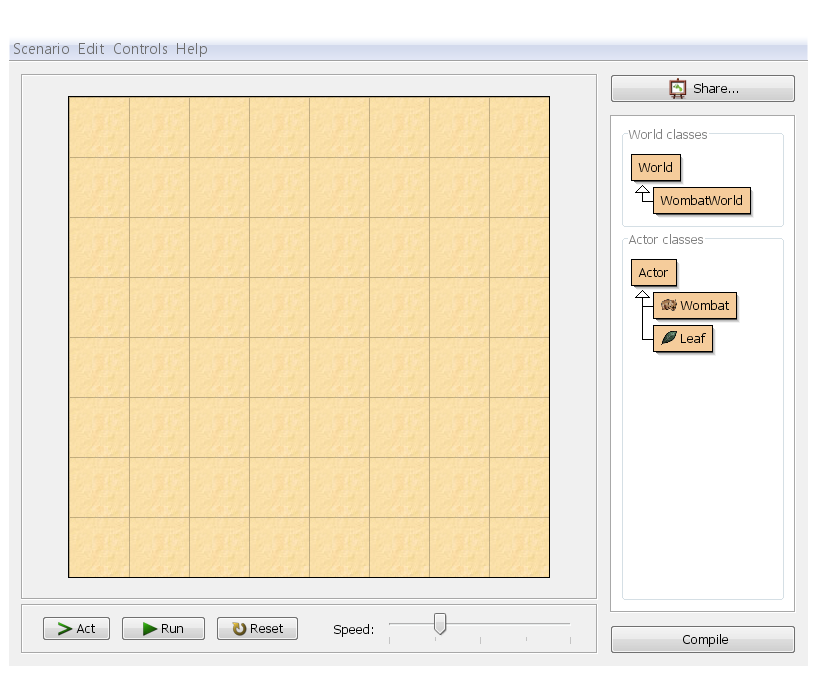Open the wombats scenario in Greenfoot; you should then see this:. Doing stuff with Objects invoking a method Now that we have made a bunch of objects we can make them do something by right-clicking them. The World class is always there in every Greenfoot scenario. This site requires JavaScript, please enable it in your browser! This shows you the object menu. This result means that when we asked the program if the wombat can move the answer was yes. Just so I understand everything, the private int moves; is what lets the program count the number of moves and the if-else statement is basically "if you've moved 24 times, eat one leave and subtract one from your total".
| Uploader: | Voodoogami |
| Date Added: | 1 May 2015 |
| File Size: | 62.9 Mb |
| Operating Systems: | Windows NT/2000/XP/2003/2003/7/8/10 MacOS 10/X |
| Downloads: | 96577 |
| Price: | Free* [*Free Regsitration Required] |
The class defines the behavior of each object. Then right-click on the wombat the one in the world, not the Wombat classand you will see that objects in the world also have a pop-up menu: Make a very big asteroid.
If you track both the x-direction and y-direction of movement with 'int' fields each holding a one or a negative one, the number of conditions will be reduced drastically. The term 'int' tells you that a whole number is expected, and the name 'howMany' suggests that you should specify how many leaves you want.
leaves-and-wombats
This is called a class diagram. This is where the method lists any extra info that it needs to run, and if it does need more info, it tells us what kind of info. Otherwise, if we can move forward, move forward.
Towards the right side of the window is the class display. The 'if-else statement' basically says "if you've moved 24 times, then, if you have previously eaten a leaf, it is consumed else you die".
Java with Greenfoot Lesson 1: Hello Wombats! | Shall We Learn
Try placing some leaves in front of the wombats, then click Act -- the wombats will move forward and eat the leaves. Java is a programming language.
You have just created a wombat in Java terms: If a wombat finds a leaf, it eats it. Some things that would need to be kept track of are 1 leaved the last move was a vertical move or not 2 whether the wombat is panning down or up the rows 3 whether we are in the middle of reversing the vertical direction of movement.
Mr. Stephenson's class
Place objects into the world We will now place some objects into the world. After you have managed to remove all asteroids or when you want stop the execution by pressing pause and find out how many shots you have fired.
The other classes belong to the wombat scenario, and will be different if you use different scenarios. We will now place some objects into the world.
The only difference between to invoking the method via the object menu is that the act button invokes the act method of all objects in the world, but the object menu only changes the one chosen object.
The arrow means this is-a relationship.
Greenfoot | leaves-and-wombats
Just using those two methods, void move and void setDirection int direction set up four of your Wombats to look like this: Click the 'Run' button. Return true if we can, false otherwise. It means that you must specify some additional bit of information when you invoke this method. To find out more, including how to control cookies, see here: This is because some leaves may be at the same location, and are lying on top of each other.
You can create objects from classes, understand method signatures, and invoke methods. Click Run and then change the slider, and you'll see the difference.

You will notice that the Run button changes to a 'Pause' button; Clicking Pause stops everything acting. Can you find a situation where it comes back as false?
Everytime a bullet hits them, their stability gets a bit smaller. Programming systems are really picky.

The old world is discarded and with it all the objects that were wombaats it -- you can only have one world active at a time. This is what I have now. Subclasses can go womhats several levels, Rocket is also a subclass of Actor, it is a subclass of Mover, which is a subclass of Actor. Think of it like 'energy', let's say your wombat started with 24 energy units, each movement consumes one unit and each leaf eaten adds 24 more units.

Комментарии
Отправить комментарий